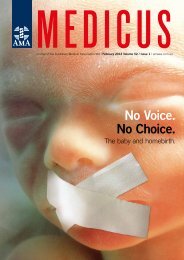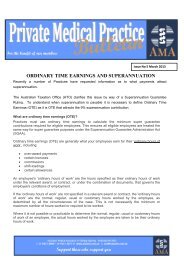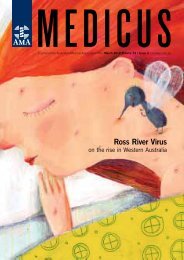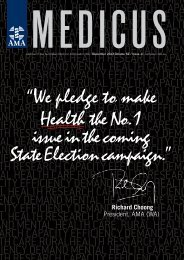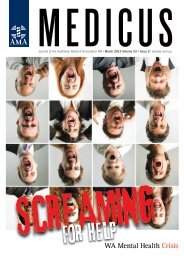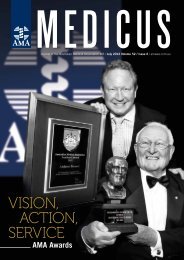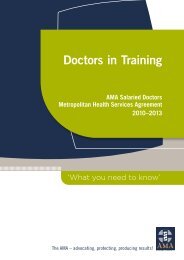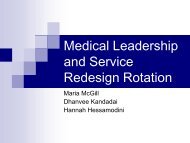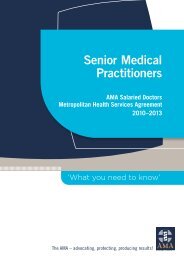twrama 1990_final oc.. - AMA WA
twrama 1990_final oc.. - AMA WA
twrama 1990_final oc.. - AMA WA
Create successful ePaper yourself
Turn your PDF publications into a flip-book with our unique Google optimized e-Paper software.
OPINION<br />
Decisions, decisions<br />
by Dr Maya Rajagopalan<br />
2012 Intern at Royal Perth Hospital<br />
am writing this article at a time when my colleagues and<br />
I friends are finding out whether they have been accepted<br />
into a training program. Some have been successful but many<br />
haven’t. For those that have, it is a time of relief and joy as<br />
they realise that their hard work and determination has been<br />
rewarded through the acknowledgement of their seniors. For<br />
those that haven’t, it is either a time of stoic resignation to<br />
another year as a junior d<strong>oc</strong>tor as they continue their current<br />
goals or despair as they reconsider their future goals and<br />
aspirations. For the few months surrounding this key moment,<br />
the conversations in the D<strong>oc</strong>tors’ Common Room f<strong>oc</strong>us<br />
on carefully dissecting what is required to enter into each<br />
specialty.<br />
The economics of medical training has become an<br />
increasingly topical subject, with such issues as university full<br />
fee-paying medical places being a regular in the news at the<br />
start of each academic year. What is not regularly discussed<br />
is the cost ass<strong>oc</strong>iated with building up the CV to a level where<br />
you will be competitive in your application to a specialty<br />
college. Courses, conferences and further qualifications can<br />
cost junior d<strong>oc</strong>tors thousands of dollars each year, placing<br />
financial strain on a population who have spent a significant<br />
time out of the workforce studying.<br />
Since the start of internship, there has been increasing<br />
pressure for my colleagues and I to choose a specialty in which<br />
to pursue a career. We are all too aware of the rising number of<br />
junior d<strong>oc</strong>tors in the system, the popularity of certain training<br />
programs, and the desire to perfect our work-life balance.<br />
This has lead many to base such an important decision on<br />
the knowledge and experiences we have gained so far, mostly<br />
coming from rotations in medical school. These experiences<br />
were brief and superficial, lacking the insight that is gained by<br />
working as a junior d<strong>oc</strong>tor in a specialty.<br />
So how can we improve this situation? I don’t believe that<br />
there is an easy solution. The financial cost incurred for<br />
training courses and attendance at conferences is a burden that<br />
must be carried. But what we can review in Western Australia<br />
is the ability of junior d<strong>oc</strong>tors to f<strong>oc</strong>us on terms in which they<br />
have an interest. We can look at the Victorian Health System,<br />
which offers early streaming<br />
into medical, surgical, and<br />
critical care rotations for<br />
Residency giving d<strong>oc</strong>tors<br />
more experiences – thereby<br />
mitigating the risk of pursuing<br />
a career in a field that they may<br />
later realise is undesirable.<br />
Such a change may assist in<br />
reducing the bottleneck that is<br />
developing due to increasing<br />
demand for specialty training<br />
by ensuring that applicants<br />
are certain of their career<br />
choices. ■<br />
32 MEDICUS October




